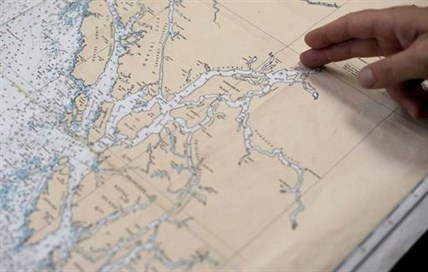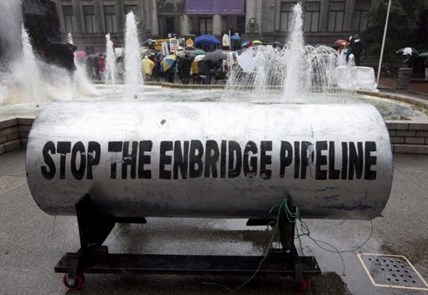
The proposed tanker route leaving from Kitimat, B.C. is show on a map Thursday, Sept, 19, 2013. Some time in the next 10 days, the federal government is supposed to announce its final decision on the Northern Gateway pipeline - the multibillion-dollar political minefield dividing the West.
Image Credit: THE CANADIAN PRESS/Jonathan Hayward
June 09, 2014 - 8:25 AM
VANCOUVER - Some time in the next 10 days, the federal government is supposed to announce its final decision on the Northern Gateway pipeline — the multibillion-dollar political minefield dividing the West.
Even detractors expect the federal government to give the $7-billion project the go-ahead.
But the nod from Ottawa would not the crest of the mountain Northern Gateway must climb before the oil — and the money — begin to flow. The path to the British Columbia coast has many hurdles left for Calgary-based Enbridge (TSX:ENB) and its partners.
A joint review panel of the National Energy Board and the Canadian Environmental Assessment Agency recommended approval of the project six months ago, subject to 209 conditions.
"The bottom line is there are 113 conditions that need to be met before construction can begin. That's going to take a lot of time," said company spokesman Ivan Giesbrecht.
If approved, that would be merely one more step in an ongoing process, Giesbrecht said.
"We have a lot of work to be done before we would be able to begin construction."
There are also the five applications before the Federal Court for judicial review of the federal panel recommendation, and further court challenges are likely.
The opposition of environmental groups was always a given. Expansion of Alberta's oil sands has become an international target for climate activists.

A protest held against the Northern Gateway pipeline in Vancouver.
Image Credit: THE CANADIAN PRESS/Jonathan Hayward
"Approval seems obvious. At the same time, opposition is so strong," said Nikki Skuce, a resident of Smithers, B.C., and a campaigner for the environmental group Forest Ethics Advocacy.
"It's going to be caught up in the courts for years and it's going to be ugly on the ground. People are willing to do what it takes."
That is no idle threat in a province that saw a decade-long War in the Woods over logging of old growth forests, which ended with new government regulations.
And opposition is not limited to environmentalists and First Nations.
Another crippling blow to the project came from the residents of Kitimat — the B.C. city with the most to gain as the pipeline terminus — when they voted to reject the project in a non-binding plebiscite.
Kitimat is no stranger to industry, born of an aluminum smelter in the 1950s, but for a majority of those who voted the risks outweigh the rewards.
Even the provincial government officially opposed the project at review hearings.
Victoria appears poised to reverse itself, deploying key ministers to a flurry of recent federal announcements on marine and pipeline safety. But the Liberal government may be waiting to see which way the political wind is blowing before they change direction.
Some facts about the Northern Gateway pipeline project:
— Its estimated cost is $7 billion and rising.
— The 1,177-kilometre twin pipelines would run from Bruderheim, just outside Edmonton, to a tanker port in Kitimat, on the northern coast of B.C.
— One pipeline would carry up to 525,000 barrels a day of oil sands products west to Kitimat for export. A second heading east would carry 193,000 barrels per day of condensate, a form of natural gas used to dilute the molasses-like bitumen to allow it to flow through pipelines.
— The westbound pipeline would carry synbit, a blend of refined synthetic oil and bitumen, two types of dilbit and synthetic oil.
— The Kitimat Marine Terminal would include two ship berths and 19 tanks to store oil and condensate. The facility would have the capacity to serve around 220 tankers per year.
— The pipeline would be worth an estimated $300 billion in additional gross domestic product over 30 years.
— Governments would net an estimated $80 billion in tax and royalty revenues over those three decades: $36 billion for Ottawa, $32 billion for Alberta and $6.7 billion for B.C. Saskatchewan would net an estimated $4 billion.
— The company says the project would result in 3,000 new construction jobs in B.C. and 560 long-term jobs.
— Northern Gateway Pipelines is a limited partnership. Calgary-based Enbridge (TSX:ENB) has a 50 per cent stake. The rest belongs to 10 private investors.
— Four of those investors remain confidential. National Energy Board documents reveal the other six are: French oil company Total; Suncor (TSX:SU); MEG Energy; Cenovus (TSX:CVE); Nexen (TSX:NXY), the Calgary company taken over last year by Chinese state-owned China National Offshore Oil Co.; and Sinopec, China's largest oil company.
Follow @ByDeneMoore on Twitter
News from © The Canadian Press, 2014